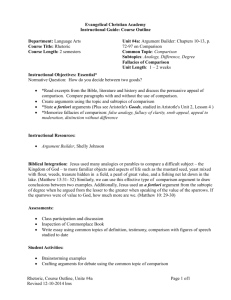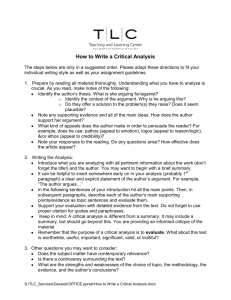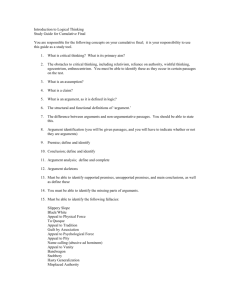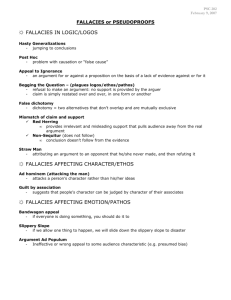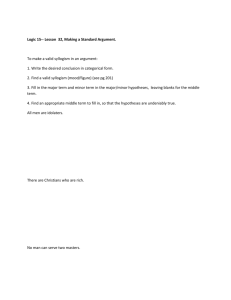argumentative writing
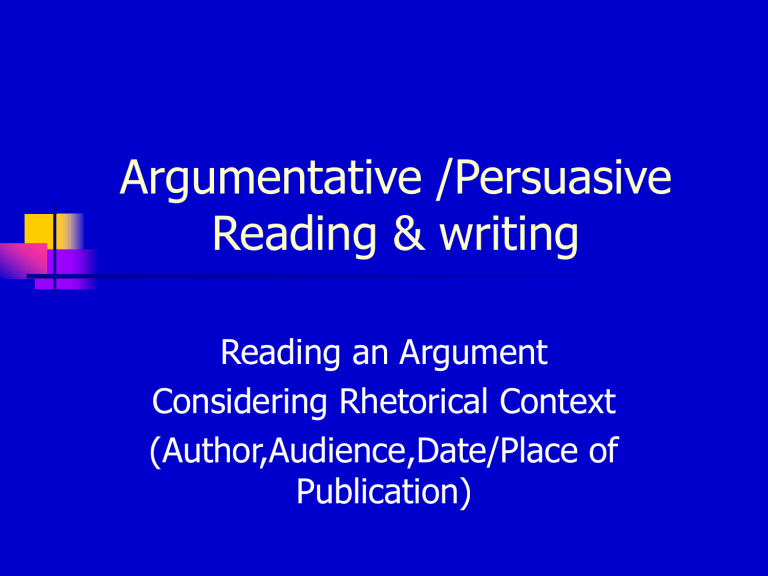
Argumentative /Persuasive
Reading & writing
Reading an Argument
Considering Rhetorical Context
(Author,Audience,Date/Place of
Publication)
Guidelines for Determining
Rhetorical Context
Who wrote this argument,and what are his/her training,personal background,and political learning?
Who is the intended audience?
Where did it appear originally?
When was the argument written?
Why was the article written?
A Step-By-Step analysis of
Toulmin Method of evaluation of logical pattern
Analyze the Claim
Identify the Claim
Look for Qualifiers: Absolute,Relative,or Universal
/”typically” /“usually” /“most of the time”
Find the Exceptions
Summarize the Claim
Assess the arguer’s refutations
Note the Counter Arguments
Argumentation versus
Persuasion
These words are often used interchangeably.
Argumentation: the process of forming reasons and of drawing conclusions and applying them to a case in discussion. An argument involves the process of establishing a claim and then proving it with the use of logical reasoning, examples, and research.
Persuasion: the tactical process of moving to a belief, position or a course of action.
Argument
Good argumentative writing is more defined when utilized with other forms of writing such as description, a short narrative, classification, cause and effect, etc.
Styles of argumentative of writing
Toulmin model:
Follows the pattern of a claim (proposition/thesis), data (support) with qualifiers, warrant, and a concession.
Rogers’ model:
Use of Rogerian arguments to come to a conclusion that mixes both views of the issue to reach a common ground.
the uses….
Everyday life
Workplace
Academic environment
Reading and Listening- (current events)
The basics of an argument
Your position and know the purpose of your essay
Analyze your audience
Reasons
Evidence: Research your topic
Audience
Write with sincerity towards audience using an ethical appeal
Don’t write with an arrogance or with disregard to opposing views
Try starting in introduction, gaining confidence of audience
This approach will show your concern and fair-minded purpose
Writing an argumentative
Choose an interesting controversial issue
Focus on a question related to your topic
Choose a position
Acknowledge opposing positions
Investigate topic and get informed
The Thesis…
Outlines and gives a clear and concise main idea of essay
Can’t be a declared fact (won’t be argumentable)
Declares something is fact, by providing evidence throughout essay
Supports a policy
Calls for action
Asserts value
Obtaining information
By reading
Conversation with others
Use your own observations
Questionnaire
Periodicals
Always cite sources used
Make sure the information you receive is relevant and credible and valid
Evidence
Includes:
Established Truths
Historical, scientific, and geographical facts
Authoritative point of view
Primary sources
Statistics
Personal experience/Examples
Managing evidence
Reliability
How much endorsing evidence?
Contradictory
How well established is evidence?
Does it support/fit your claim?
Allow it to be conclusive
The Three Persuasive Appeals
Logos:
Logic- the appeal to reason
Pathos:
Emotion- the appeal to emotion
Ethos:
Credibility- the appeal of one’s character
Logos: reasoning strategies
Induction: A process through which the premises provide some basis for the conclusion.
Deduction: A process through which the premises provide conclusive proof for the conclusion. Reductio ad Absurdum: (to reduce to absurdity) To question a position by showing that its consequence are problematic if carried to their logical end.
Questions of Credibility
Has the reader been able to rely on what you have said in the past? If they are unfamiliar with you…
Do you know what you’re talking about? Are you familiar with all sides of the issue?
Have you done your research on the issue?
Have you documented your research thoroughly and accurately?
Have your thoughtfully addressed the opposition?
Some Ways to Use the Three
Appeals
Credibility Logic Emotion
Show that you are fair- and openminded
Point to other
“experts” or an authority other than yourself
Cite research
Show why people should listen to you and you believe
Rely primarily on facts
Use deductive or inductive reasoning to reach your conclusion
Use classical argument, including reason and evidence to support your claim
Use emotionally charged or highly connotative words
Appeal to peoples fears, concerns, passions, vanity, sense of justice, and so forth
Take advantage of rhythm and refrain in language
Syllogism
The simplest sequence of logical premises and conclusions every syllogism contains at least three parts:
a major premise (global assumption) a minor premise (specific claim)
a conclusion
IF A=B and B=C, then A=C
Enthymeme
shorten version of syllogism a syllogism without stating either the major or minor premise (it is implied) less formal than the syllogism sometimes more persuasive are often “because” statements
Fallacies= mistakes made in the logic of arguments
Common fallacies found in arguments include:
Hasty Generalizations- a conclusion based on insufficient or biased evidence
Non Sequitur- “It does not follow”
Slippery slope- the snow ball effect
Card Stacking-presenting part of the claim
Stereotyping
Ad populum- an emotional appeal that speaks to positive (such as patriotism, religion, democracy) or negative (such as terrorism or fascism) concepts rather than the real issue at hand
Fallacies (cont.)
Either/Or
Begging the claim- conclusion that the writer should prove is validated within the claim( Circular argument)
Arguing Off the point
The argument ad Hominem- “attack the person’s character than their opinion”
Appeal to crowd
Guilt by association
Post Hoc, ergo Propter Hoc-”after this, therefore because of this”
Faulty analogy: assuming two unlike things are similar when in fact they are not
Red Herring
Avoid also…
Strawman tactics- pointing out and focusing on flimsy weaknesses of opposing side.
Anonymous authority- refers to a source of authority but does not name the source nor explain its legitimacy.
This will show that you are trying to prove your position by disregarding other facts.
True argument vs. valid argument
true argument- argument that has conclusion that people commonly consider to be fact based on their worldly experience or widespread belief valid argument- argument that has a conclusion that logically follows its underlying assumption regardless of whether the assumption is true or not
Revising
Consider the objections of the opposing appeal
Do you capture the audience?
Is evidence appropriate to the argument?
Are the authorities qualified to be used as a source?
Is the proposition clearly stated?
Is it free of fallacies?
Tips of writing an essay
Avoid emotional language
Be able to determine difference between a logical conclusion and an emotional point of view
Don’t make up evidence
Cite your sources
Make an outline- DO THE WRITING PROCESS
Be prepared to defend your side by knowing the strongest arguments for the other side.
Concluding
Restate your position.
Summarize your main points.
Predict the consequences if it does or does not prevail.
Prepare to end your essay possibly with an emotional appeal.


